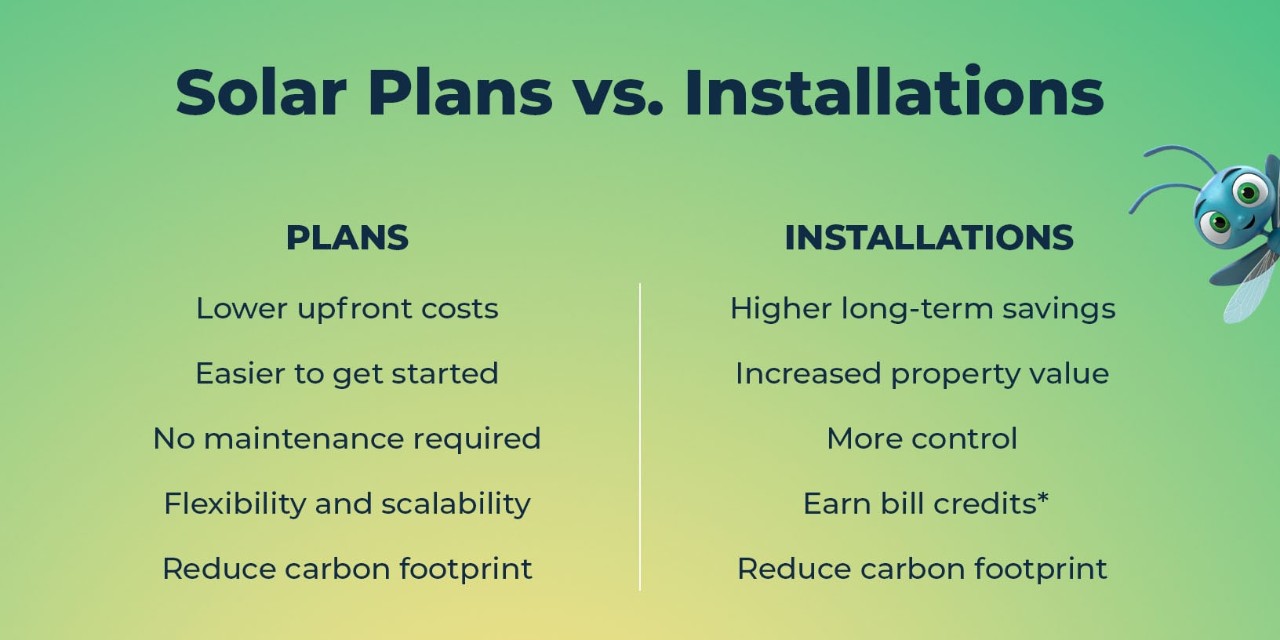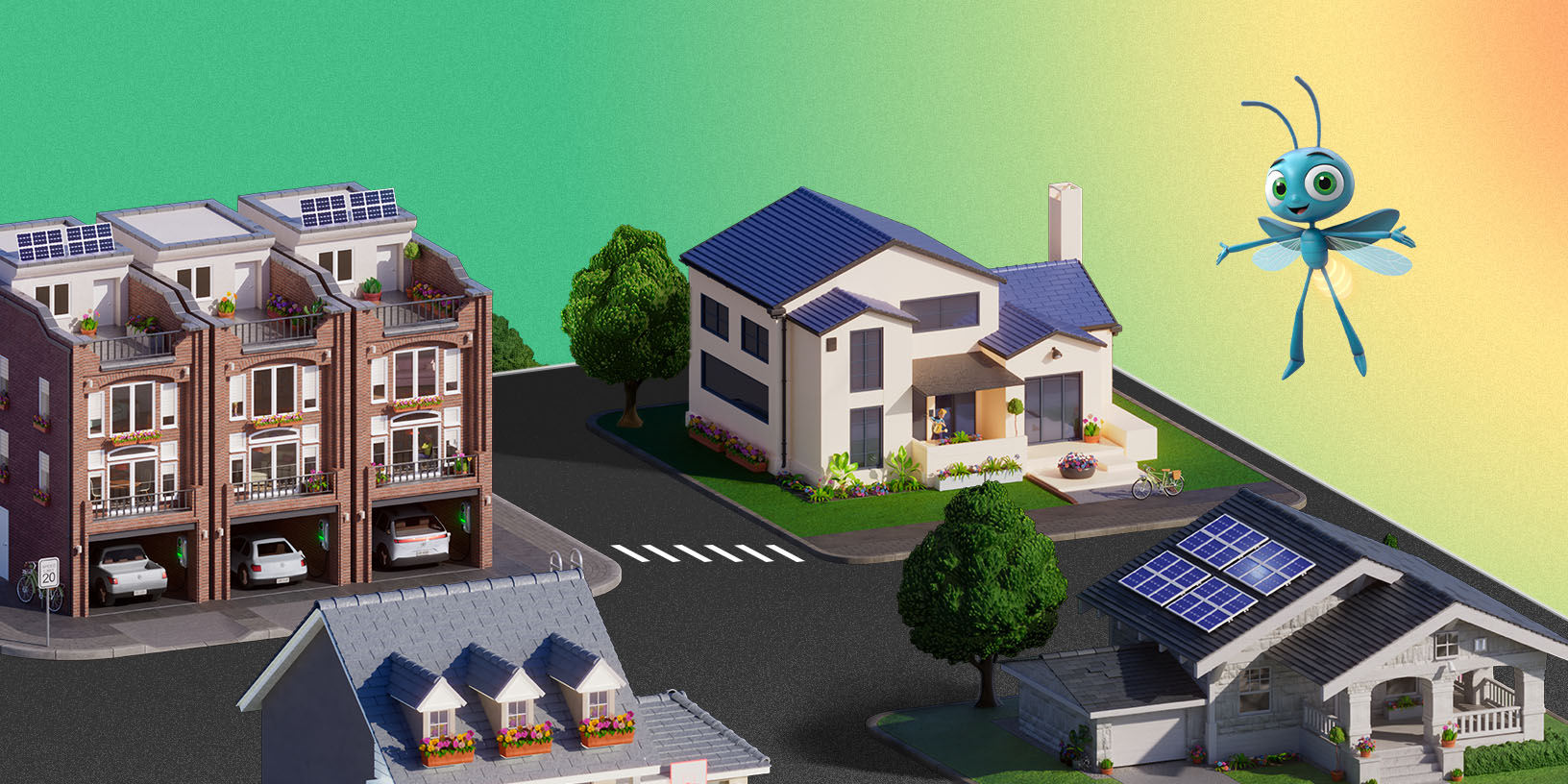Green Mountain Energy's Guide to Going Solar
Know Your Options: Solar Plans vs. Installations

When we talk about solar power, you may think that solar panels are the only way to power your home with renewable, clean energy from the sun.
In this article, we will explore the two avenues for harnessing solar power in your home: solar panels and solar-powered plans.
Solar plans vs. installations
Solar electricity plans (or green energy plans from other sources like wind) do not require the installation of solar panels. Instead, they rely on solar farms that collect solar energy from sunlight, convert it into electricity and send it to your electricity grid which powers your home. No upfront cost, no roof installation – just a cleaner way to power your home.
Solar panel installation allows you to harness the energy of the sun to create your own electricity to power your home. If you are enrolled in a solar buyback plan and if you produce excess electricity from your solar panels and send it back to the grid, you may receive credits or payments for that surplus energy.
While both options are ideal for those looking to get into clean energy, there are pros and cons to both solar panels and plans. Let’s shed more light on the benefits of solar plans vs. installations so you can determine which option is right for you.
Core Considerations for Choosing Solar Plans vs. Solar Panels
Whether you decide to purchase a solar energy plan from a retail electricity provider or install solar panels on your home boils down to six core considerations: whether you rent or buy, how long you plan to live in your home, the process of getting started with solar panel installation, where you are located, property logistics and your financial readiness.
Renting or Buying
If you rent your home or live in an apartment complex, you should choose a solar plan, like our Go Local Solar plan or other clean energy plan like those powered by wind.
Your landlord or property manager may decide to install solar panels, but unless you own the property or have special permission in your lease agreement to make these kinds of changes, a solar energy plan is a great way to decrease your carbon footprint.
How Long You Plan to Live in Your Home
The average American homeowner lives in their home for about 12.5 years, so a large portion of your decision could lie with how long you plan to live in your current home – and if you will be able to stay beyond your solar payback period.
The solar payback period is the time it takes for the savings generated by your solar energy system to cover the initial investment cost. The average payback period for a solar panel installation ranges from six to 10 years. With this in mind, investing in solar panels makes the most sense if you’ll be in your home for at least 10 years.
Logistics of Getting Started
The process of installing solar panels can be very detailed and requires lots of decision-making, starting with choosing the right solar panel installer. The solar panel installation process involves:
- Site assessment
- Obtaining permits
- Choosing your electricity provider
- Selecting the type of solar panel that is right for you
The logistics of your solar panel installation may take months, but the actual process of bringing the panels to your home and setting them up may take only a day or two.
The Layout of Your Property
Some properties may not be well suited for solar panels. There are many important factors used to determine whether or not a home is well suited for panels, including:
- Roof conditions and possible repairs
- Roof age and material
- Size of the roof
- Layout variables like large trees
- Direction of the sun
Financial Considerations
When you switch from a traditional energy plan to a solar energy plan, there are minimal upfront costs outside of a cancellation or switching fee. However, solar panel installation does have such costs. It’s a significant investment in your property and how you power your home.
Solar panel installation costs can run into the tens of thousands of dollars. For example, the median cost of an 11-kW solar panel installation in Texas is $30,529 before any applicable tax credits.
Many solar-savvy homeowners take part in a solar buyback program, like Green Mountain Energy’s Texas-based Renewable Rewards® program. These credits go right back onto your bill!
Understanding Community Solar/Shared Solar Plans
Community solar, also known as shared solar, lets more people benefit from solar energy without needing to install panels. It's a great option for renters, homeowners without the right roof setup or anyone looking to support clean energy while lowering their electricity costs.
Green Mountain Energy has teamed up with local solar developers in New York, Illinois and Massachusetts to bring community solar to more people. By subscribing to one of these shared solar projects, customers can support clean energy in their community and earn up to 10% savings on their annual electricity bills.
How It Works
- Solar energy is generated by a local community solar farm and sent to the local power grid.
- Your subscription is tailored to your energy usage, ensuring you receive the right amount of clean energy credits each month.
- These solar credits appear on your electricity bill, which reduce your monthly costs for up to 10% savings annually.
- There’s no equipment to install, no fees to enroll, and you can cancel anytime.
Maximize Your Solar Savings: Choosing Between Solar Plans vs. Solar Installations
We’ve covered what you need to consider about your living and financial situation to decide whether a solar energy plan or a solar panel installation is right for you. Now we can discuss the pros and cons of each option.

Solar Plan Pros and Cons:
Pros:
- Lowers upfront costs
- Easier to sign up and get started with same-day service
- No maintenance required
- Solar plans offer more flexibility for renters and homeowners alike
- Supports the growth of solar energy across the board (the more people opt for green energy, the easier it is to build more solar parks!)
- Reduces carbon footprint
Cons:
- Typically, lower energy savings compared to installing solar panels
- Limited control over energy production
- Lack of ownership over solar energy
- Inability to take part in buyback initiatives
Pros and Cons of Solar Panels
Pros:
- Higher long-term savings on energy bills.
- Increased property value.
- Federal incentives are available for many consumers.
- Earn bill credits* for excess energy produced (only if you are on an energy plan that allows for this)
- Achieve solar independence
- Reduce carbon footprint
Cons:
- High initial investment
- Ongoing maintenance responsibilities
- The installation process can be complex.
Ready to Go Green with Green Mountain Energy?
As we conclude our exploration of the pros and cons of solar plans vs solar panel installations, homeowners and renters have viable options if they’re interested in powering their home with solar energy.
Whether you opt for a solar plan from a trusted electricity company or decide to install solar panels on your property, the transition to solar energy helps protect the planet and can offer real-world cost-saving benefits.
No matter where you are in your solar power journey, Green Mountain Energy has the solution that’s right for you. All of our home energy plans use 100% clean, renewable energy, and we’re here to help you every step of the way.
Take a big step for the planet with a renewable energy plan.
Enter your ZIP code to get started.
March 10, 2025
Explore the growing influence of solar energy and its benefits for the environment and local communities. This article covers how solar is replacing fossil fuels, the latest adoption trends, and the positive effects on greenhouse gas emissions.
March 08, 2025
Not ready to install solar panels? No problem. Learn about renewable energy plans that allow you to power your home with 100% clean energy without the need for rooftop panels. Compare plans and find the one that best suits your needs.
March 07, 2025
Understanding your energy usage is essential for determining if solar power is right for you. This article helps you evaluate your consumption patterns and estimate how solar energy can reduce your costs and lower your carbon footprint.


